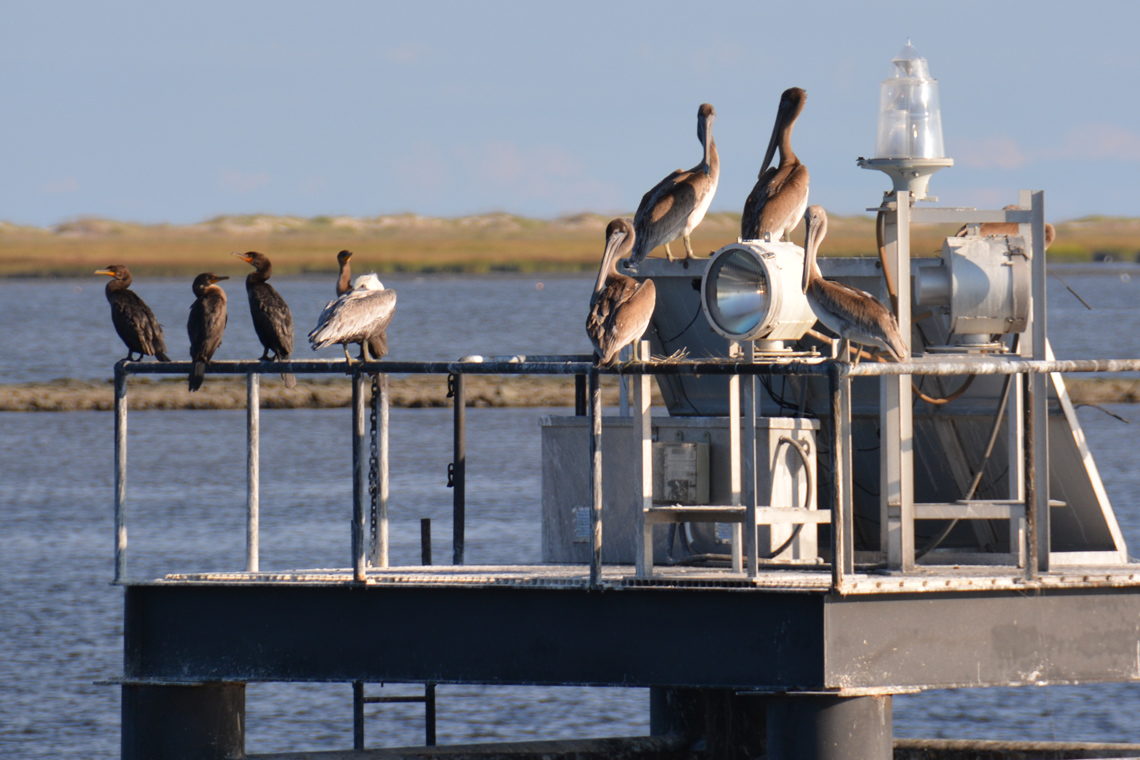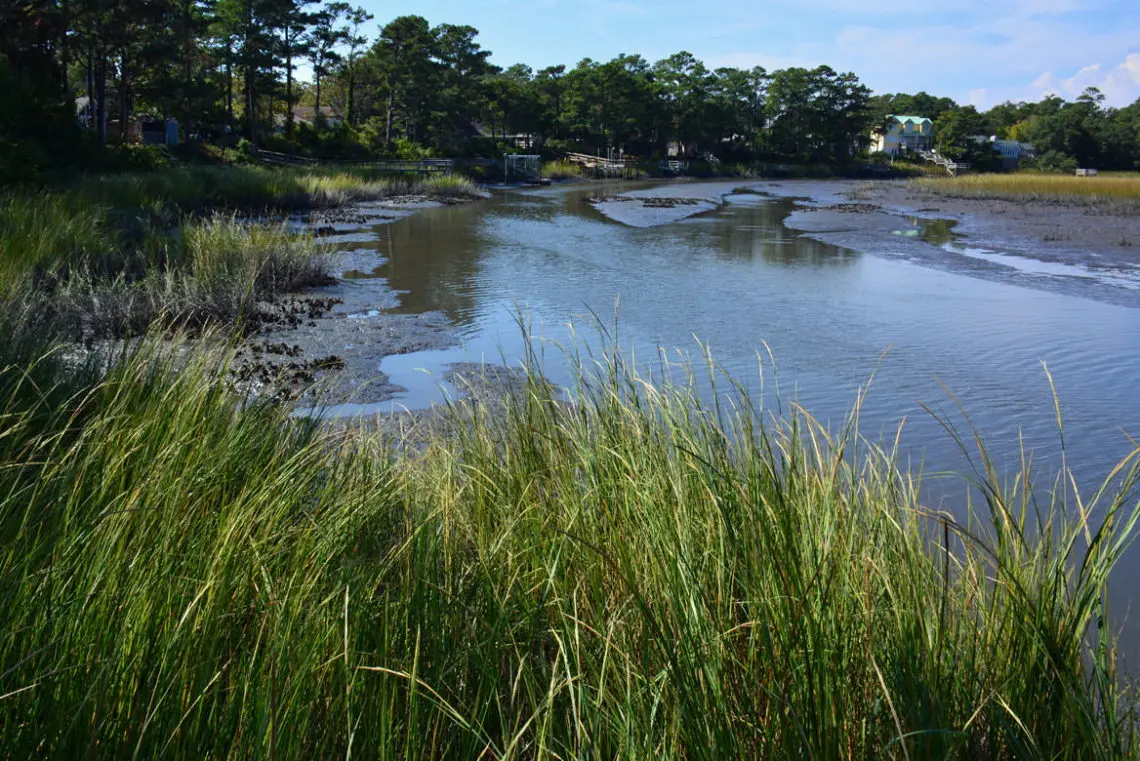
Visitors who take a trip to the very southern tip of the North Carolina coastline will be treated to a wild landscape where the local wildlife thrives – the Bird Island Reserve.
Situated on the border of North and South Carolina, this collection of marshy islands and shoreline is a paradise for beachcombers, kayakers, birdwatchers, and any visitor who enjoys a pristine piece of the coastline. Fairly easy to reach and yet wonderfully isolated, the Bird Island Reserve is a breath of fresh air for anyone who appreciates a purely natural exploration.
About Bird Island Reserve
Bird Island has been around for generations, but the continual movement of sand and sediment has shifted the geography of this island to the collection of beaches, marshes, and wetlands that it is today. The 1,481 acre site, (which includes 135 acres of uplands and more than 1,300 acres of marshes and tidal flats or subtidal areas), was acquired by the state in 2002, and was the 10th site added to the NC Coastal Reserve and National Estuarine Research Reserve. Bird Island is part of six State Reserve Sites, (there are also four National Reserve sites), and additional state sites include nearby Bald Head Woods, Buxton Woods and Kitty Hawk Woods in the Outer Banks, and Permuda Island is southeastern Onslow County.
The site is a prime example of a barrier island shoreline with a few occurrences of rare species for the area. The array of habitats within the site include dune grass, maritime dry grassland, maritime wet grassland, maritime shrub thicket, maritime swamp, brackish marsh, salt flat, and salt marsh, and ocean beaches, which serve as a permanent (or temporary) home for a wide range of species. Most notable, the island shoreline is a popular nesting area for loggerhead sea turtles, and flora and fauna lovers can find the rare and threatened seabeach amaranth (Amaranthus pumilus) in the foredune region.
The site itself is located in between the town of Sunset Beach in North Carolina, and the Little River Inlet in South Carolina, which makes it the southernmost shoreline in the state. Bordered by a network of canals and the Intracoastal Waterway to the west, and the Atlantic Ocean to the east, the area is literally surrounded by water, which in turn, allows all varieties of marine and sea life to thrive.
Accessing Bird Island Reserve
Visitors can access the Bird Island Reserve by foot or by boat, and will want to start their trek by heading south from the Cape Fear area to the town of Sunset Beach.
On foot explorers will want to drive through the island Sunset beach community all the way south to the borders of the Bird Island Reserve. Head to the intersection of 40th and Main Streets where limited parking is available, just past the intersection on the edge of Main Street. (Overflow parking may also be available along the street as well, but watch for non-parking zones and residential areas.) From here, explorers will want to take the 40th street boardwalk to the beach and turn right. Eventually, the crowds will thin, and the signs announcing the entrance to the reserve will appear.
Visitors who are exploring the site via a boat or kayak can land on the beach close to the Little River Inlet on the South Carolina side of Bird Island Reserve. Though there are ample places to explore in the area, (including Bonaparte Creek, Clayton Creek, and the East River), mariners will want to use ample caution throughout as the depths of the sound and marsh areas can fluctuate depending on the tides.
Once on the beach, visitors can walk the entire length of the shoreline which extends for roughly .9 miles until reaching the Corps of Engineers property which is found approximately 0.4 miles from the state line. The maritime shrub thickets may be accessible as well, but visitors will want to note that the reserve tends to get soggier and more difficult to traverse the farther you go from the ocean beaches.
Things to Do on Bird Island Reserve
Once on Bird Island Reserve, visitors will find a wide array of things to do that naturally go hand in hand with a nicely isolated barrier island shoreline. Make the most out of your island expeditions by enjoying these activities which are effortlessly available in this stunning reserve.
Shelling – The wide flat beaches that are heavily influenced by tides, as well as the gradually sloping ocean floor and relatively shallow waves, makes Bird Island Reserve a tempting spot for beachcombing. Visitors will want to keep an eye out for coquinas, cockles and clam shells, whelks, and occasional sand dollars that may wash up with a low or high tide, or particularly after a summer storm or hurricane.
Birdwatching – As the name would quite aptly suggest, Bird Island Reserve is a great spot for birdwatchers of all varieties. Look for a wide range of shore and water birds close to the tidal flats and ocean shoreline, including brown pelican, skimmers, least terns, plovers, ibises, egrets, and herons. For a better perspective, bring along a camera and head to the marshes where the water birds tend to feed.
Swimming – The ocean beaches along Bird Island Reserve are nicely shallow, with few other visitors and plenty elbow room. Beachgoers will find that they can often “walk out” into the water for a while still being able to touch bottom, while the waves are generally gentle, especially in the summer months. Swimmers should note, however, that there are no lifeguarded beaches within the reserve, and will want to proceed at their own risk.
Kayaking – Bird Island Reserve is a fantastic spot for kayakers of all skill levels, as the gentle river and creek waters as well as the changing landscape that alters with the tides can be challenging for both beginner and expert paddlers alike. Explore the wider creeks such as Bonaparte Creek and the East River for relatively smooth sailing, and use caution around the inlets where the currents can be deceptively swift.
Fishing – Anglers, (and especially kayak fishermen), will have a fine time exploring the waters in and around Bird Island. The local Little River Inlet, Intracoastal Waterway, and wide creeks / channels like the East River and great destinations for casting a line, and the ease of reaching these isolated channels makes a fishing expedition even more enticing. Just be sure you get a North Carolina Saltwater Fishing license ahead of time to enjoy miles of stress-free and beautifully natural fishing grounds.
Hiking – The terrain on the Intracoastal Waterway side of the reserve may be a little soggy, but hikers who love ocean breezes will find plenty of reasons to keep strolling along the shoreline. Measuring just a mile or so long, the trek along the beach is pleasant, scenic, and easily accessible which makes it a great destination for hikers of all ages and abilities, and the ensuing exploration highlights the beauty of the North Carolina coastline throughout the trek.
Wildlife Photography – Nature fans and birdwatchers alike will find plenty of reasons to bring a camera along on an exploration of the Bird Island Reserve. While the marshy areas have ample viewing points and / or observation decks, the oceanside beaches and sand suns are stunning sets with cool ocean waves, nearby wildflowers, and plenty of wildlife to keep visitors snapping photos. For exceptional landscape shots, try to plan a trip around sunrise or sunset to enjoy an ocean view that’s covered by a rainbow-hued skyline.
Visiting the Kindred Spirit Mailbox – One of Bird Island Reserve’s most unique attractions is also one of its few manmade additions – the Kindred Spirit mailbox. Nestled along the dunes, the mailbox is a place for visitors to share their notes, reflections, and other perspectives via a personal letter, or in one of the notebooks which is usually stationed in the mailbox’s interior. A cool attraction that allows visitors an opportunity to share their love of the island environment, the Kindred Spirit Mailbox is a favorite destination for new and seasoned Bird Island visitors alike.
Tips and Tricks for Visiting Accessing Bird Island Reserve
- Be sure and bring along trash bags and take out whatever you bring in. There are limited (if any) trash receptacles along the shoreline, and the reserve has a strict litter policy to protect the local wildlife.
- Be sure and watch for beach closures in the summer and fall months that correspond with sea turtle nesting season, and avoid these roped-off areas accordingly.
- Watch out for research equipment. Researchers at the state’s various reserves often leave research equipment in the field for long-term data collection, and this equipment should remain undisturbed by visitors.
- Note that there is no camping allowed at any of the reserve sites, (including Bird Island), with the exception of the Masonboro Inlet Preserve which is found in between the Cape Fear island communities of Carolina Beach and Wrightsville Beach.
- Pets are allowed on the NC Coastal Reserve sites, although they must be leashed at all times to ensure that your furry friend does not disturb the local wildlife.
- Want to learn even more about Bird Island Reserve? The Bird Island Preservation Society Stewards often offers seasonal walking tours of the shoreline from June through August which depart from the 40th Street Walkover at Sunset Beach. Check out the NC Coastal Reserve website at http://www.nccoastalreserve.net/web/crp/bird-island for information on special programs and / or to become a steward yourself!
Bird Island is a paradise of a destination for beachcombers who want to leave the crowds behind, and who want to enjoy miles of scenery all to themselves. Relatively easy to reach and effortlessly easy to enjoy, Bird Island Reserve is a prime example of a North Carolina shoreline that has been perfectly preserved, and where the stunning ocean landscapes, cool coastal marshes, and abundant wildlife always steal the scene.
Visitors who are on the hunt for the postcard-perfect vacation rental in the heart of the Carolina Beach or Kure Beach area will find an enticing selection and plenty of friendly customer service when they rent through Victory Beach Vacations. Based...
Welcome to the newly renovated Dry Dock Inn, your perfect Carolina Beach retreat. Just steps from the sand and boardwalk, our inn combines modern updates with coastal charm for an unforgettable stay. From effortlessly comfortable individual rooms to...
There’s an ocean of adventures waiting for visitors at the Jungle Rapids Family Fun Park. Featuring a full range of entertainment options including a water park, mini golf course, go karts, arcade, and so much more, veritably every visitor...
Take a break from the beach and enjoy the winding canals and creeks that border the Elizabeth and Cape Fear Rivers with a visit to the May Moore Park. This small destination, located on the northeastern side of Oak Island, is within walking distance...
New visitors may find that making a list of things to do during a packed Cape Fear vacation seems, initially, like an impossible task. With a wealth of incredible attractions, activities, and stunning landscapes, it’s hard to narrow down the...





